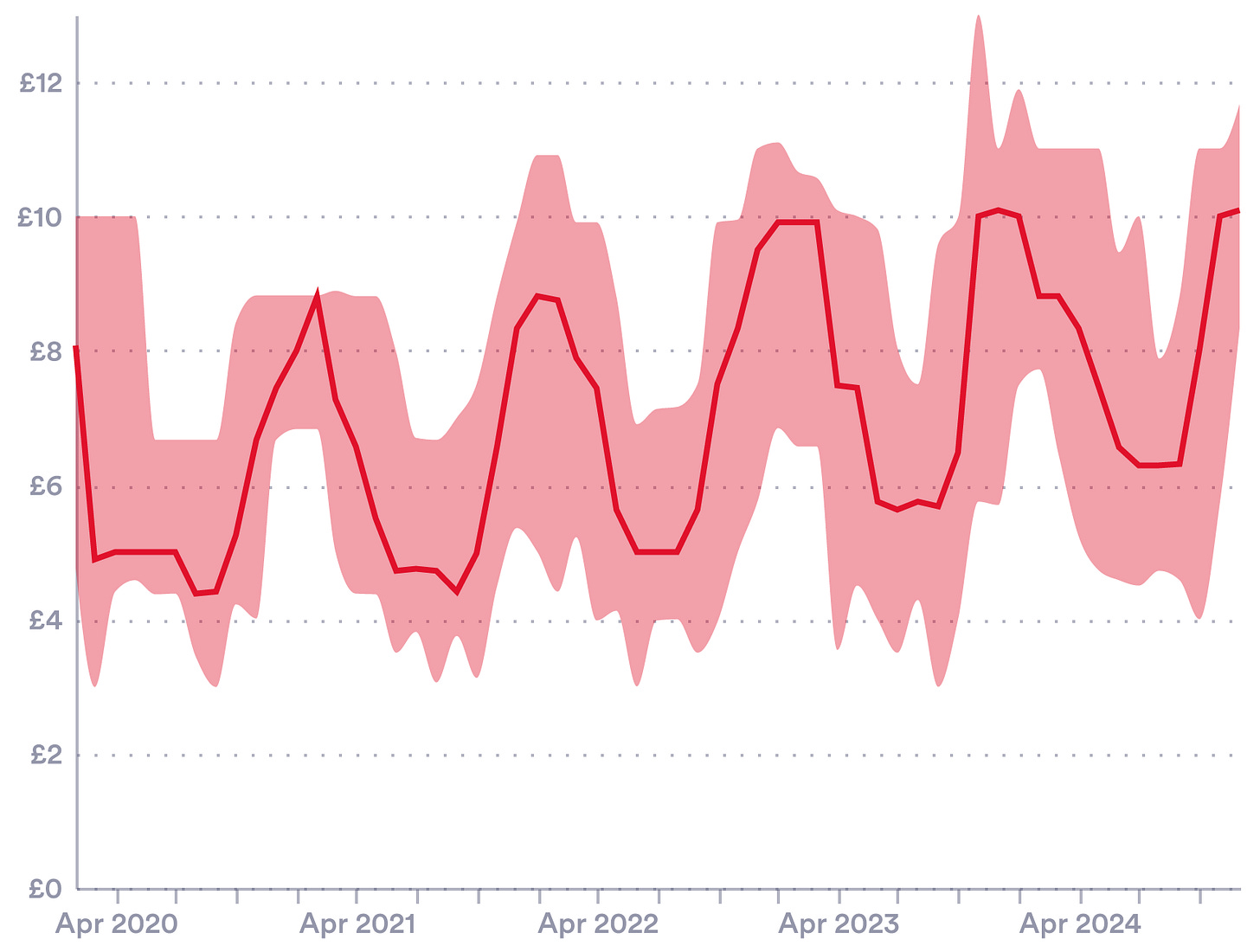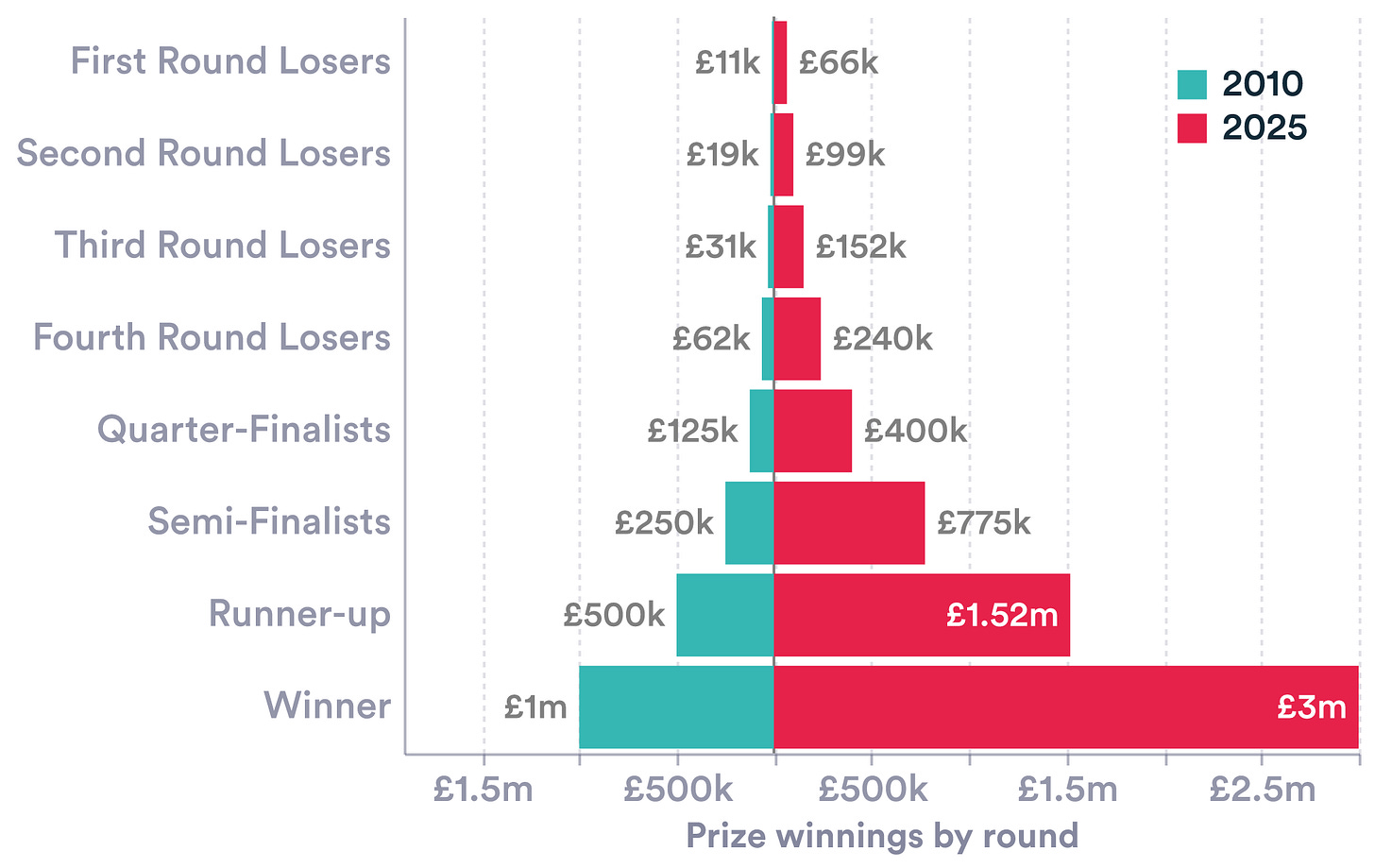
After last week’s weighty topic—war and inflation—today we are back with something lighter. What can Wimbledon tell us about the economy?
But first an invitation to subscribers. Next week we will host the BBC’s Ben Chu to discuss his new book—Exile Economics—at an in-person event in London. (Weds 9th July, 6:30pm, LSE). You can get your ticket here.
The strawberry rollercoaster
Wimbledon started this week. The tournament was first held in 1877, becoming an official championship event in 1923 – the term “grand slam” came into use in 1930s. (It comes from the card game bridge).
A staple of the British summer season this year more than 500,000 people are expected to attend. Of these, a lucky few (just 1,500 each day) will get one of the show court tickets by joining The Queue.
Once through the gates, strawberries and cream, served at Wimbledon since 1877, are a priority. This year a pot costs £2.70—pretty reasonable given London prices (as our national Guinness analysis shows). In fact, prices were held at £2.50 between 2010 and 2024—sourcing locally had allowed Wimbledon to keep the price “accessible”, its chief executive recently explained.
Local is indeed cheaper, when it comes to fruit. Using the underlying data that goes into the official UK inflation numbers, we can track strawberry prices. The first thing that jumps out is the seasonality. Prices tend to peak in December and are at their lowest in September (Chart 1, below).
Chart 1. Strawberry prices
Notes: Price per KG of fresh strawberries. 10th-90th percentile price range shaded.
Source: ONS via Davies (2021; updated 2025).
The price rollercoaster is caused by trade. During the summer, strawberries are home grown. In June, July and August imports fall to almost zero, as farms in Kent, Sussex, and Herefordshire pump out plump produce. By contrast a Christmas strawberry tends to come from North Africa (Egypt, and then Morocco, produce the most). That adds in extra costs of packaging, refrigeration, transport and tariffs (Chart 2).
Chart 2. Strawberry imports
Notes: Excludes imports from other regions (3% of the total). Source: UN COMTRADE
Prices rise
Wimbledon’s prices are a reminder of how inflation works. Our data goes back to 1988. That summer, Stefan Edberg pipped Boris Becker to the men’s title and Steffi Graf beat Martina Navratilova. Strawberries cost 58p per pound in the UK, cream was 32p per carton. Since then, these prices have risen by around 400% and 690% respectively.
This whopping food inflation far outpaces general prices in Britain. The CPI basket has risen 170% from 1988 to 2024. Median earnings are up more, by 281%, so ‘inflation-adjusted’ earnings (aka living standards) have risen.
Chart 3. Winning prize money, by event
Source: Wimbledon, AELTC.
Wimbledon players’ pay has risen far faster. (Prize money was introduced in 1968, at £2,000). Graf and Edberg took home £148.5k and £165k respectively in 1988. Today’s singles’ winners (the favourites are Carlos Alcaraz and Aryna Sabalenka) will pocket almost 20 times more, £3m. With a record prize pot of almost £54m (Chart 4, below), even first-round losers earn £66k.
Chart 4. Total prize pot
Source: Wimbledon, AELTC.
Earnings inequality is a hot topic in tennis, with tour players reportedly sleeping in cars, and accruing large debts to keep training. At Wimbledon the difference between winners and losers has softened in recent years. Since 2010 the winners’ prize has tripled but first-round losers’ payout has risen by a factor of six. As a share of the total prize pot, ladies’ and men’s champions share has fallen from around 20% to 15% (Chart 5).
Chart 5. Prizes by round
Source: Wimbledon, AELTC.
Fully automated Wimble-nomics
Automation is everywhere at the moment and Wimbledon is not immune: the courts seem bare this year because the line judges are gone, replaced by cameras. Data can be automated too. Since 2023 we have been gathering prices and using AI tools (OpenAI’s GPT4.1) to clean and organise them. Our dataset now holds almost 70m prices. How do Wimbledon prices compare to the very latest for the UK economy?
Looking across seven UK supermarkets, we found 59 strawberry options. Prices vary more within stores than between them: most have a wide range of options from £4.5 per kg, all the way up to premium berries at £10 or more.
Some outlets are introducing novel twists. The M&S strawberries and cream sandwich has gone viral on TikTok. It’s apparently so sweet that there is controversy over whether it should be treated as a sandwich (which would attract no VAT) or confectionary by tax collectors.
There are even more options when it comes to cream. Since 2023, we’ve tracked fully 179 types. Single cream is the cheapest at around 48p per 100ml, on average, a little behind whipping (50p), and double (55p).
Those making their own Wimbledon pudding at home are in luck; each July, about one in seven cream products sold in supermarkets are on sale (Chart 6). The discounts are large, averaging 24%.
Chart 6. Cream discounts
Notes: Percentage of cream products that are marked price discounts. Source: Economics Observatory AutoCPI dataset.
Finally, what about a Centre Court tipple? A bottle of Lanson champagne goes for £96 at Wimbledon this year, Pimm’s is £12.25. You can bring your own (one bottle per person) bringing the supermarkets back into play. Once again Britain’s consumer economy puts on a plethora of options: we found prices ranging from £14.95 all the way to £280. You can spend less than at Wimbledon, or a lot more. ●
REFERENCES
Prices and wages
How have wages changed over the last 50 years for different segments of the population? ONS data
What can we learn from decades of price microdata? 45 million UK prices (Richard Davies, 2021 updated, 2024)
Can artificial intelligence help us to measure inflation? Economics Observatory (2024)
Strawberries and cream
How does the new M&S strawberry and cream sandwich taste? Daisy Lester in the independent gives it four stars. But is it legally a sandwich or confectionary?
Who sells the most strawberries? Tesco, British Berry Growers data shows.
Where do we import our fruit from? COMTRADE reveals all.
The tennis lifestyle













Can you explain how long the British government has been paying more for its debt than other G7s, and why? Also the impact of post - growth UK and EU?